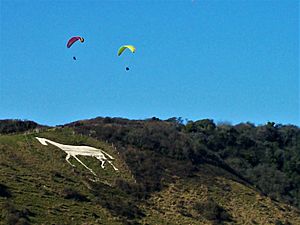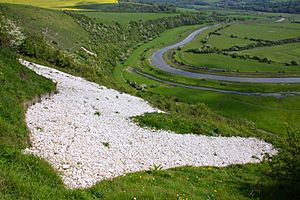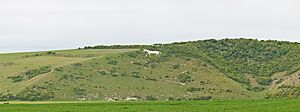Litlington White Horse facts for kids
The Litlington White Horse is a giant horse shape carved into a hillside. It's a type of artwork called a hill figure, made by removing grass to show the white chalk underneath. You can find it on Hindover Hill in the South Downs, looking over the River Cuckmere. It's near the village of Litlington in East Sussex, England.
The horse you see today was created in 1924. It was carved by John T. Ade, Mr. Bovis, and Eric Hobbis in just one night! This amazing chalk horse is 93 feet long and 65 feet high. Before this one, another horse was carved in the same spot, either in 1838 or 1860.
Since 1991, the National Trust has owned the Litlington White Horse. They work with local volunteers to keep it clean and in good shape. This horse is one of only two famous hill figures in East Sussex. The other is the Long Man of Wilmington, which is about 3 miles away.
Contents
The First Litlington White Horse
The exact story of the first White Horse is a bit of a mystery. People aren't sure when it was made or who made it.
When Was the First Horse Made?
One idea is that James Pagden and his family created it in 1838. They might have done it to celebrate Queen Victoria becoming queen. Another story says that two local boys carved the horse in 1860. They supposedly saw a patch of chalk that looked like a horse's head. Then they decided to carve the rest of the horse around it.
Where Was the First Horse?
Sadly, the first horse wasn't looked after very well. By the early 1910s, grass had completely covered it. The last time anyone saw it was around the late 1900s before the new one was carved. Records suggest the original horse was about 100 yards north-west of where the current horse is now. But its exact spot is still unknown.
The Current White Horse
The horse we see today was carved in 1924. John T. Ade, Mr. Bovis, and Eric Hobbis did the work. John T. Ade was the son of William Ade, who might have helped create the first horse. It's thought that some of these men were related to the people who made the original horse.
A Secret Night Carving
They carved the horse in one night, under a full moon. The local people didn't know about it! Imagine waking up to a giant horse on the hillside. This surprise might have been why they carved it so quickly.
Keeping the Horse Safe
Local people have helped look after the horse ever since. In the late 1930s, the horse was covered up. This was during World War II to stop it from being used as a landmark by enemy planes.
After the war ended in 1945, the horse was uncovered. But some parts of its shape changed. For example, one leg wasn't carved back until June 1949. More changes were made then to make the horse look like it did originally.
In the late 1980s, the East Sussex County Council cleaned the horse. They also put wooden boards around it to keep the chalk in place. A fence was added to stop farm animals from damaging it. At this time, the horse's position was changed. It went from standing to a "prancing" position. This helped stop the chalk from slipping. The horse was last cleaned and repaired in 2016.
The Unicorn Horn Incident
In May 2017, someone added a unicorn horn to the horse! It was a bit of a surprise, but the horn was quickly removed.
Visiting the Litlington White Horse
You can find a free car park at the top of Hindover Hill, along Alfriston Road. From there, it's a short footpath walk down to see the White Horse up close.
However, many people say the best view of the horse is from across the valley. You can get this view by walking south along the banks of the River Cuckmere from Litlington village.




